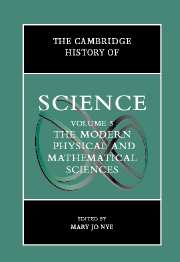Book contents
- Frontmatter
- Introduction: The Modern Physical and Mathematical Sciences
- Part I The Public Cultures of the Physical Sciences After 1800
- Part II Discipline Building in the Sciences: Places, Instruments, Communication
- Part III Chemistry and Physics: Problems Through the Early 1900s
- Part IV Atomic and Molecular Sciences in the Twentieth Century
- 17 Quantum Theory and Atomic Structure, 1900–1927
- 18 Radioactiviy and Nuclerar Physics
- 19 Quantum Field Theory: From QED to the Standard Model
- 20 Chemical Physics and Quantum Chemistry in the Twentieth Century
- 21 Plasmas and Solid-State Science
- 22 Macromolecules: Their Structures and Functions
- Part V Mathematics, Astronomy, and Cosmology Since the Eighteenth Century
- Part VI Problems and Promises at the End of the Twentieth Century
- Index
- References
22 - Macromolecules: Their Structures and Functions
from Part IV - Atomic and Molecular Sciences in the Twentieth Century
Published online by Cambridge University Press: 28 March 2008
- Frontmatter
- Introduction: The Modern Physical and Mathematical Sciences
- Part I The Public Cultures of the Physical Sciences After 1800
- Part II Discipline Building in the Sciences: Places, Instruments, Communication
- Part III Chemistry and Physics: Problems Through the Early 1900s
- Part IV Atomic and Molecular Sciences in the Twentieth Century
- 17 Quantum Theory and Atomic Structure, 1900–1927
- 18 Radioactiviy and Nuclerar Physics
- 19 Quantum Field Theory: From QED to the Standard Model
- 20 Chemical Physics and Quantum Chemistry in the Twentieth Century
- 21 Plasmas and Solid-State Science
- 22 Macromolecules: Their Structures and Functions
- Part V Mathematics, Astronomy, and Cosmology Since the Eighteenth Century
- Part VI Problems and Promises at the End of the Twentieth Century
- Index
- References
Summary
The concept of the macromolecule was formed and evolved within the framework of two sciences that emerged in the twentieth century: polymer chemistry (or macromolecular chemistry) and molecular biology. Over the past three decades, a large number of books have been published on the history of these two fields. While practicing scientists have provided their personal reminiscences as well as technical reviews, historians have shed light on intellectual, institutional, and industrial aspects of the history of these sciences.
The existing literature, however, has rarely covered both fields simultaneously. Just as polymer chemistry and molecular biology are separate disciplines that have demarcated the communities and goals of the practitioners, in like manner have their histories been compiled and treated in isolation. While historians have been eager to look into the origins of molecular biology, they tend to pay little attention, if any, to polymer chemistry. The historical link between polymer chemistry and molecular biology is a subject yet to be explored. The macromolecule was a common conceptual ground that sustained the intellectual framework of the two sciences: Scientists of both fields sought a causal chain of evidence from macromolecular structures to their properties and functions. The development of the two sciences may well be seen as a process of elaboration of the macromolecular concept, as well as the “molecularization” of the physical and life sciences. In keeping with this perspective, this chapter will focus on the “science of macromolecules” from the 1920s to the 1950s.
- Type
- Chapter
- Information
- The Cambridge History of Science , pp. 429 - 446Publisher: Cambridge University PressPrint publication year: 2002
References
- 2
- Cited by



